| 10th Royal Hussars (Prince of Wales's Own) | |
|---|---|
 Badge of the 10th Royal Hussars Badge of the 10th Royal Hussars | |
| Active | 1715–1969 |
| Country | |
| Branch | |
| Type | Cavalry |
| Role | Line cavalry |
| Size | 1 Regiment |
| Nickname(s) | Baker's Light Bobs, The Chainy 10th, The Shiny 10th |
| Motto(s) | Ich Dien (I Serve) |
| March | (Quick) The Merry Month Of May |
| Anniversaries | El Alamein (23 Oct) |
| Commanders | |
| Notable commanders | John Vaughan Reginald Barnes |
The 10th Royal Hussars (Prince of Wales's Own) was a cavalry regiment of the British Army raised in 1715. It saw service for three centuries including the First World War and Second World War but then amalgamated with the 11th Hussars (Prince Albert's Own) to form the Royal Hussars (Prince of Wales's Own) in October 1969.
History
Early history
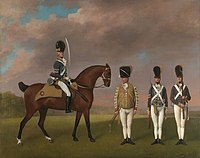
The regiment was formed at Hertford in 1715 as Gore's Regiment of Dragoons, one of 16 raised in response to the 1715 Jacobite rising. The Rising ended before the unit was ready for action; while most of these temporary formations were disbanded in 1718, Gore's remained in being and spent the next 25 years on garrison duty, primarily in the West Country. It first saw active service during the 1745 rising, at the Battle of Falkirk Muir in January 1746 and the Battle of Culloden in April. As part of the reforms enacted by the Duke of Cumberland, it was retitled the 10th Regiment of Dragoons in 1751.
During the 1756 to 1763 Seven Years' War, it took part in the June 1758 Raid on St Malo, followed by the battles of Minden in August 1759, Warburg in July 1760 and Kloster Kampen in October, where the commanding officer, Colonel William Pitt, was badly wounded and taken prisoner. It then fought in the Allied victory at Villinghausen in July 1761, which forced the French onto the defensive and ultimately led to the Treaty of Paris in 1763.
In 1779, the light troop was detached to form the 19th Regiment of (Light) Dragoons; in 1783, it became the 10th (Prince of Wales's Own) Regiment of (Light) Dragoons in honour of the future King George IV. As a result of its connection with the Prince of Wales, the regiment became known for elaborate and expensive uniforms and the high personal income required to be an officer. In June 1794, Beau Brummell, an arbiter of men's fashion in Regency London, was given a commission as cornet but resigned in 1795 when it moved from London to Manchester.
Napoleonic Wars
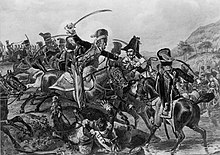
In 1806, the regiment was again re-designated, this time becoming a hussar regiment as the 10th (Prince of Wales's Own) Regiment of (Light) Dragoons (Hussars), and sailed for Corunna in Spain in November 1808. The regiment saw action at the Battle of Sahagún in December 1808 and the Battle of Benavente later in December 1808 during the Peninsular War. At Benavente the regiment captured General Charles Lefebvre-Desnouettes, the French cavalry commander. The regiment then took part in the Battle of Corunna in January 1809 before returning to England.
In 1813, having landed once more in Spain, the regiment fought at the Battle of Morales in June 1813. During the battle the regiment destroyed the 16th French Dragoons between Toro and Zamora, taking around 260 prisoners. The regiment also fought at the Battle of Vitoria later in the month while still in Spain and then, having advanced into France, fought at the Battle of Orthez in February 1814 and the Battle of Toulouse in April 1814. As part of the 6th Cavalry Brigade, the regiment charged the French cavalry and infantry at the Battle of Waterloo in June 1815.
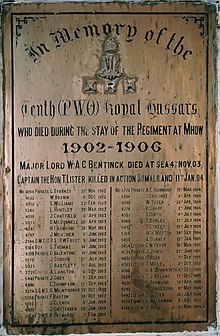
Victorian era

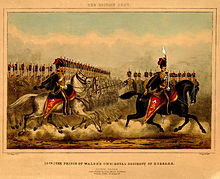

The regiment was sent to India in 1846 and then saw action at the Siege of Sevastopol in winter 1854 and at the Battle of Eupatoria in February 1855 during the Crimean War. In 1861, it was renamed the 10th (The Prince of Wales's Own) Royal Hussars. The regiment saw action at the Battle of Ali Masjid in November 1878 during the Second Anglo-Afghan War and at the First and Second Battles of El Teb in February 1884 during the Mahdist War.

With the outbreak of the Second Boer War, the regiment sailed for South Africa in November 1899. After fighting at Colesberg, the regiment participated in the relief of Kimberley in February 1900. It was also involved at the Battle of Diamond Hill in June 1900. Following the end of the war in 1902 they went to India. Almost 375 officers and men left Cape Town on the SS Lake Manitoba in September 1902, arriving at Bombay the following month and was then stationed at Mhow in Bombay Presidency.
The regiment was next deployed in action on the North-West Frontier in 1909.
The First World War
The regiment, which was based at Potchefstroom in South Africa at the start of the war, returned to the UK and then landed at Ostend with the 6th Cavalry Brigade in the 3rd Cavalry Division in October 1914 as part of the British Expeditionary Force for service on the Western Front.
Inter-war
After the war the regiment saw brief service in Ireland. On 22 June 1921 it provided the royal escort for King George V when he opened the first Parliament of Northern Ireland. Two days later the train carrying the detachment back to the south was mined, killing and wounding twenty-four hussars and eighty of their horses. The regiment returned to the UK in 1921 and was retitled the 10th Royal Hussars (Prince of Wales's Own). Deploying to Egypt in 1929 and India in 1930, the regiment returned to the UK in 1936 and began the process of mechanisation. It was assigned to the 2nd Armoured Brigade of the 1st Armoured Division in 1939. At the same time, it became part of the Royal Armoured Corps.
The Second World War
With the outbreak of war, the 1st Armoured Division deployed to France. It fought in northern France and Belgium, returning to England without any vehicles in June 1940. In December 1940, a group of personnel was detached to form the cadre of the 23rd Hussars. In November 1941, the regiment deployed to North Africa with the 2nd Armoured Brigade, joining 7th Armoured Division. Now equipped with Crusader tanks, it saw action in Operation Crusader, at the Battle of Alam el Halfa in August 1942 and at the Second Battle of El Alamein in October 1942. At El Alamein the regiment captured General Wilhelm Ritter von Thoma, the German Deputy Commander. The regiment then fought both as an armoured unit and as dismounted infantry during the Italian Campaign in 1944 and 1945.
Post-war
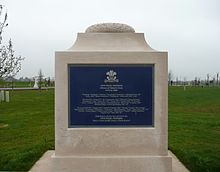
The regiment was deployed to Lübeck in Germany as an armoured regiment in the British Army of the Rhine in 1946. It moved to Epsom Barracks in Iserlohn in 1948 and then returned to the UK in July 1953. It then deployed to Aqaba in Jordan in February 1956 in operations in support of the Jordanian Government: 19 members of the regiment were killed in an air crash at El Quweira in April 1957. After returning to the UK again in July 1957, the regiment moved to Swinton Barracks in Munster in July 1959 and then transferred to Barker Barracks in Paderborn in June 1960. It returned home again in March 1964 and then deployed to Aden in August 1964 during the Aden Emergency. The regiment moved to York Barracks in Munster in September 1965 and after returning home in September 1969, amalgamated with the 11th Hussars (Prince Albert's Own) to form the Royal Hussars (Prince of Wales's Own) in October 1969.
Regimental museum
The regimental collection is held by HorsePower: The Museum of the King's Royal Hussars which is based at Peninsula Barracks in Winchester.
Battle honours
The regiment's battle honours were as follows:
- Early wars: Warburg, Peninsula, Waterloo, Sevastopol, Ali Masjid, Afghanistan 1878–79, Egypt 1884, Relief of Kimberley, Paardeberg, South Africa 1899-1902
- The Great War: Ypres 1914 '15, Langemarck 1914, Gheluvelt, Nonne Bosschen, Frezenberg, Loos, Arras 1917 '18, Scarpe 1917, Somme 1918, St. Quentin, Avre, Amiens, Drocourt-Quéant, Hindenburg Line, Beaurevoir, Cambrai 1918, Pursuit to Mons, France and Flanders 1914-18
- The Second World War: Somme 1940, North-West Europe 1940, Saunnu, Gazala, Bir el Aslagh, Alam el Halfa, El Alamein, El Hamma, El Kourzia, Djebel Kournine, Tunis, North Africa 1942–43, Coriano, Santarcangelo, Cosina Canal Crossing, Senio Pocket, Cesena, Valli di Commacchio, Argenta Gap, Italy 1944-45
Uniform
The regiment wore standard red dragoon coats with "deep yellow" facings until the dark blue uniform and crested helmet of light dragoon was authorized in 1784. Hussar dress was adopted through a series of separate measures, culminating with the introduction of a busby in 1809. Until 1914 the entire regiment wore dark blue hussar uniform for full dress with a red busby bag, yellow braiding, white plume and yellow stripes on their riding breeches. Officers had a distinctive pattern of criss-crossed gilt metal decoration on their pouch-belts, which gave the regiment its nickname of "The Chainy 10th".
Regimental band
The regimental band dates back to as early as 1786. In the 1850s, the band served with the regiment in India and then in Afghanistan. On the occasion of the Coronation Durbar in December 1911, when King George V visited India, trumpeters of the regiment were granted permission to wear the royal livery. When the regiment moved to Bloemfontein, the band became very popular with the public. The band also accompanied the regiment in India during the 1920s and 30s. It was one of the first bands to visit troops in France after the D-Day landings. The band then served with the hussars in West Germany during the Cold War. In 1961 it was paraded for the last time, with the last Drum Horse of the 10th Royal Hussars. When the regiment returned to Tidworth to amalgamate with the 11th Hussars in 1969, to form The Royal Hussars, the two regimental bands were merged.
Victoria Crosses
- Sergeant Henry William Engleheart - Second Boer War, 13 March 1900
- Lieutenant Sir John Milbanke, 10th Baronet - Second Boer War, 5 January 1900
Commanding Officers
| This list is incomplete; you can help by adding missing items. (February 2021) |
The Commanding Officers have been:
- 1959–1962: Lt.-Col. John M.D. Ward-Harrison
- 1962–1965: Lt.-Col. William S.P. Lithgow
- 1965–1968: Lt.-Col. John B. Willis
- 1968–1969: Lt.-Col. Bernard C. Greenwood
Colonels-in-Chief
- 1898–: F.M. King Edward VII
- 1910?–: F.M. King George V
- 1937–: F.M. Prince Henry, Duke of Gloucester, KG, KT, KP, GCB, GCMG, GCVO
Regimental Colonels
Colonels of the Regiment were:
- Humphrey Gore's Regiment of Dragoons
- 1715–1723: Lt-Gen. Humphrey Gore
- 1723–1745: Lt-Gen. Charles Churchill
- 1745–1749: F.M. Sir Richard Temple, 1st Viscount Cobham
- 1749–1780: Gen. Sir John Mordaunt, KB
- 10th Regiment of Dragoons (1751)
- 1780–1796: Gen. Sir William Augustus Pitt, KB
- 10th (Prince of Wales's Own) Regiment of (Light) Dragoons (1783)
- 1796–1820: Col. The Prince Regent
- 10th (The Prince of Wales's Own) Royal Regiment of (Light) Dragoons (Hussars) (1811)
- 1820–1843: Gen. Charles William Vane Stewart, 3rd Marquess of Londonderry, KG, GCB, GCH
- 1843–1863: Gen. Henry Beauchamp Lygon, 4th Earl Beauchamp
- 10th (Prince of Wales's Own Royal) Hussars (1861)
- 1863–1901: F.M. Prince Albert Edward, Prince of Wales KG, KT, KP, GCB, GCSI, GCMG, GCIE, GCVO
- 1901–1912: Maj-Gen. Lord Ralph Drury Kerr, KCB
- 1912–1924: Maj-Gen. Hugh Richard Dawnay, 8th Viscount Downe, KCVO, CB, CIE
- 10th Royal Hussars (Prince of Wales's Own)(1921)
- 1924–1935: F.M. Sir Julian Hedworth George Byng, 1st Viscount Byng of Vimy, GCB, GCMG, MVO
- 1935–1939: Brig-Gen. Thomas Walter Brand, 3rd Viscount Hampden, GCVO, KCB, CMG
- 1939–1947: Col. Victor John Greenwood, MC
- 1947–1949: Lt-Gen. Sir Charles Willoughby Moke Norrie, 1st Baron Norrie, GCMG, GCVO, CB, DSO, MC
- 1949–1952: Lt-Gen. Sir Charles Henry Gairdner, GBE, KCMG, KCVO, CB
- 1952–1962: Brig. Charles Barnet Cameron Harvey, DSO
- 1962–1969: Maj-Gen. Sir David Dawnay, KCVO, CB, DSO (to Royal Hussars)
- 1969: Regiment amalgamated with 11th Hussars (Prince Albert's Own) to form The Royal Hussars (Prince of Wales's Own)
Alliances
Notable former members
- Donald Crisp
- Peter H. Jackson
- Norman Wisdom
- John Boyle O'Reilly
- William Stuttaford
- Beau Brummell
- Robert Pate
- John Lambton, 1st Earl of Durham
References
- ^ "10th Hussars". Regiments.org. Archived from the original on 6 January 2007. Retrieved 18 August 2016.
- Griffin, Charles. "10th Dragoons". British Empire. Retrieved 13 February 2019.
- Cannon, p. 16
- Cannon, p. 18
- Cannon, p. 22
- Cannon, p. 24
- Cannon, pp. 25-26
- Cannon, p. 28
- Doran, John (1857). Miscellaneous Works, Volume I: Habits and Men, Beau Brummell. Richard Bentley. p. 379.
- "No. 13677". The London Gazette. 24–28 June 1794. p. 619.
- Cannon, p. 36
- ^ Cannon, p. 37
- ^ "10th Hussars". National Army Museum. Archived from the original on 2016-08-21. Retrieved 18 August 2016.
- Cannon, p. 42
- Cannon, p. 45
- Wellesley, Arthur (1838). The Dispatches of Field Marshal the Duke of Wellington, During His Various Campaigns in India, Denmark, Portugal, Spain, the Low Countries, and France: From 1799 to 1818. Compiled from Official and Authentic Documents. J. Murray. pp. 416–7.
- Cannon, p. 50
- Cannon, p. 57
- Cannon, p. 60
- Cannon, p. 65
- "Battle of Kabul 1879". British Battles. Retrieved 18 August 2016.
- "The Battle of El Teb". British Battles. Retrieved 18 August 2016.
- ^ "10th Hussars". Anglo-Boer War. Retrieved 18 August 2016.
- "The Army in South Africa - Troops returning home". The Times. No. 36884. London. 27 September 1902. p. 10.
- "Naval & Military intelligence - The Army in India". The Times. No. 36896. London. 11 October 1902. p. 12.
- "The 10th Hussars". The Long, Long Trail. Retrieved 18 August 2016.
- Bennett, Richard. The Black and Tans. p. 180. ISBN 978-1-86227-098-5.
- ^ "10th Hussars". British Army units 1945 on. Retrieved 18 August 2016.
- Knight, Tom. "10th Royal Hussars: Aqaba 1956-57". The XRH Club. Retrieved 18 August 2016.
- "The museum". Horsepower. Archived from the original on 7 June 2016. Retrieved 29 July 2016.
- Carman, W.Y. Richard Simkin's Uniforms of the British Army. The Cavalry Regiments. pp. 133–140. ISBN 978-0-906671-13-9.
- "HorsePower – The Regimental Band of the 10th Royal Hussars (PWO)". Horsepowermuseum.co.uk. Retrieved 2020-03-29.
- "Regimental Music - The King's Royal Hussars". Krh.org.uk. Archived from the original on 2020-03-29. Retrieved 2020-03-29.
- "Regiments and Commanding Officers, 1960 - Colin Mackie" (PDF). p. 25. Retrieved 4 February 2021.
Sources
- Cannon, Richard (1843). Historical Record of the 10th The Princes of Wales's Own Royal Regiment of Hussars. John W. Parker.
| King's Royal Hussars | |||||
|---|---|---|---|---|---|
| Predecessors |
| ||||
| Victoria Cross | |||||
| See also | |||||
- Cavalry regiments of the British Army
- Hussar regiments of the British Army
- Military units and formations established in 1715
- Military units and formations disestablished in 1969
- Cavalry regiments of the British Army in World War I
- Regiments of the British Army in World War II
- Regiments of the British Army in the Crimean War
- 1715 establishments in Great Britain